Model life cycles - Page one
Today we buy appliances with the knowledge that in a few months the manufacturer will alter the design, either a little or alot and either cosmetically, functionally or both. Sometimes this is not necessary and a ploy by manufacturers to build some obsolescence into their products in order to get the market to buy more when an item fails. After two or three years you should expect the parts that went into what you purchased to be superceded by new parts, the older parts no longer made.
If anyone thinks this is a modern day habit then they can think again. In the golden age of radio this sort of thing went on in leaps and bounds, just as it does today. It affected people alot less then because things were generally made to last a long time and because of that people didn't throw away what they no longer needed in the house. When companies like AWA and Philips started making transistors people put their valve sets in the shed or garage instead of taking them to the tip. They still worked well so there was no need to throw them away.
This didn't stop the manufacturers making small changes through a model's life though. Some changes amounted to simple cosmetic alterations as time went on. A receiver might have sported a new dial every so often as new stations began operations. A cabinet may have been strengthened due to prior design defects. Functional changes may have meant things as simple as a cabinet's feet may be moulded as an integral part of a cabinet one minute and seperate rubber items screwed on the next. Then there were the substantial differences such as offering a 240 volt mains model as well as a set that ran from batteries so that rural listeners could listen in.
Below are some of the examples I have noticed in my collection where radio makers have changed things. You be the judge as to whether they were changes for the better or turns for the worst.
The AWA Radiolette of the late 1940's
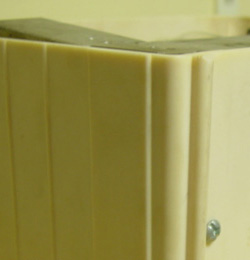
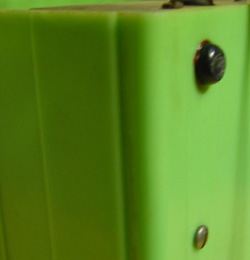
NOTE: The cabinet on the left sports feet which are moulded as part of the cabinet itself whilst the cabinet on the right, a slightly earlier build, sports rubber feet which are glued on.
This is not all that differentiates these Radiolettes. Over time, AWA changed the layout of the chassis quite dramatically, and everything ends up virtually mirror-reverse which the follwing photos show.
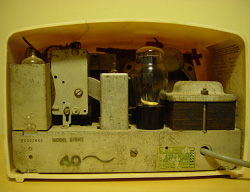
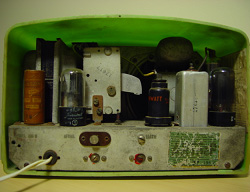
NOTE: The power transformer is on the right in the first photo. The power cords are on the same side as the power transformer in each model, a sign that economies of scale were pondered on at the time.
I believe that the white set on the left is the later model of the two. The small post office licence transfer on the white receiver along with the fact that not having moulded feet on a bakelite cabinet means that a task can then be removed from the production process which in this case was gluing rubber feet onto the set. The plastic covered flex on the white set was placed there by me and when I restore it I will certainly be using something more authentic in its place.
Astor variations
The Astor sets described here were strongly built and probably very expensive too. The cabinets are very thick and everything outside and inside is laid out in a luxurious and spacious fashion. We feature three sets here, the first two are mains powered and the third is a battery powered set which runs from a 4 volt A battery for the valve filaments and a 63 volt B battery.
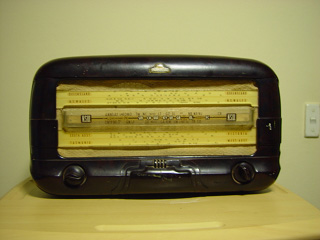
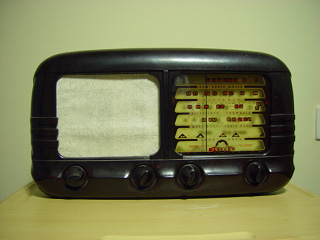
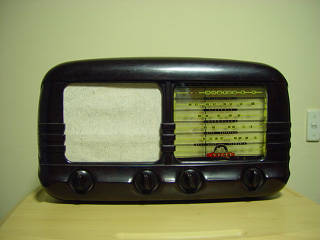
NOTE: The first set is probably the most recent of all three because it has a plastic dial and follows a convention of the late 1940's where, especially in small sets, the dials were more relevant to the State the radio was sold in, rather than showing stations for the whole continent. In no other product is Federalism more prevalent!
The first receiver pictured above is a 240 volt model and has four valves. It's quite a large cabinet for a four valve chassis though after about 50 years, this set still works and puts out a respectable volume on all local stations. The second set has a five valve chassis. I've never got around to plugging this one in, though I did get rid of the moth-eaten grille cloth. The white grille cloth on both this and the third set are temporary and they'll be replaced by a more appropriate material shortly. The third set has four valves and being a battery powered set, this number is the equivalent of a mains powered five valver. This set works though I find that it gives best performance when the B battery voltage is lowered slightly and a lengthy aerial and solid earth are used. All these sets have 150mm (6 inches on the old scale) loudspeakers and the sound quality is excellent.
Note some of the minor differences between the receivers. Firstly, the dials, the first being plastic as mentioned before. The second and third are glass but they still have slightly different designs. The large decoration between the knobs on the first set is merely a cover or 'blank' for the two extra knobs not required in this model. I am yet to see if this wide-dialled version was available with four knobs. Check the centre divider on the two bottom receivers. The first one is removable and has no decoration, indicating that the same cabinet could have also been used for the wide-dialled model above. Note how the wide-dialled version at the top has no fluting on its side decoration whereas the other two sets have three flutes on each side. The bottom set has fluting on its centre divider too and in this case, the divider is part of the cabinet. If you try to remove this one you'll need some Tarzan's Grip to put it back!
Which page would you like to go to?
1|2

Sign In

Vintage Radio and Television is proudly brought to you by an era where things were built with pride and made to last.
DISCLAIMER: Valve radios and televisions contain voltages that can deliver lethal shocks. You should not attempt to work on a valve radio or other electrical appliances unless you know exactly what you are doing and have gained some experience with electronics and working around high voltages. The owner, administrators and staff of Vintage Radio & Television will accept no liability for any damage, injury or loss of life that comes as a result of your use or mis-use of information on this website. Please read our Safety Warning before using this website.
WARNING: Under no circumstances should you ever apply power to a vintage radio, television or other electrical appliance you have acquired without first having it checked and serviced by an experienced person. Also, at no time should any appliance be connected to an electricity supply if the power cord is damaged. If in doubt, do not apply power.
Shintara - Keepin' It Real · VileSilencer - Maintain The Rage
